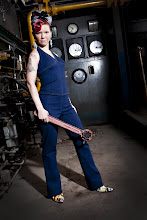Sunday, December 20, 2009
Basics to Curating a small space
When hanging your work,make sure you choose the order of your work carefully; make sure the sizes and color schemes of each piece coincide together in a certain harmony. Basically, Know your color wheel. Knowing your complimentary and Secondary colors will help you greatly in choosing which work should go next to each other. If your work is in black and white or sepia tones, you can skip this and go strictly by the sizes of the works themselves, and possibly the composition of the content.
Now, line up your choices and make sure the distance between two pieces on a wall next to each other are half the width of the piece itself in order not to pull attention from each piece of artwork. Over crowding a wall looks sloppy. This isn't a Walmart whole sale,This is an art showing. Presentation is everything, so keep it classy, don't overcrowd! A common mistake that many small cafes and spaces make in order to “fit more work in” is putting pieces on top of each other. If there is one thing that perturbs Ms. Bombshell more when going to a show,it's seeing work displayed this way ; NEVER DO THIS! In my eyes, there is almost nothing more sloppy looking than displaying work this way. I understand that your space is small, Spacing is difficult, but If you can avoid this, please do so, because it makes the work at the top difficult to see, as well as distracts. It takes away from the work itself by having pieces to close together. A solution to this is to first off, stick to small scale work.. Watercolorists tend to work small on a lot of occasions, tap into that resource!
A galleries walls should only be white or a muted gray. Having your walls any other color or series of colors will limit the type of work you can use in a space. For example: now due to too strong of a contrast, you can no longer use black and white or sepia toned photography(unless your walls are brown but then that's all you can use!). The reason for this is that the wall and the piece will be fighting for your eye's attention. The Contrasting elements will compete with each other and you will lose a lot of details in your work, The human eye simply won't pick them up! If your peepers can't grasp what they are looking at they will simply block it out. Your eyes won't register a lot of it. What's the point of looking at artwork if it isn't going to stay in your vision and memory?
If you are new at hanging work you should definitely have a level in your tool kit; and yes,you do indeed need a tool kit. It should include (of course) a level, a hammer, lots of nails, screws, thumb tacks, a drill, a tape measure, a marking pen, and extra hanging wire. If you are experienced at this then, eventually you won't need the level or the tape measure. You'll get pretty good at being able to eyeball it, I can almost guarantee that after hanging 5 or 6 shows you should be able to take the measuring tools out of your kit. If not, then you can find me and yell at me for lying. I'm bad at math and wear glasses and I can do it with ease now, So 5 or 6 for you could even be too many! Good eyes or bad eyes measuring without a ruler is something you can master quickly.
The rest is relatively basic, choose, line up, install, enjoy! At this point(and a little practice) you should be able to seamlessly install your or your artists' show. So Happy hanging, and much luck from Ms. Bombshell!
Subscribe to:
Post Comments (Atom)

No comments:
Post a Comment